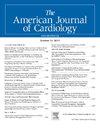Predictors and Long-Term Prognostic Significance of Bailout Stenting During Percutaneous Coronary Interventions With Sirolimus-Coated Balloon: A Subanalysis of the Eastbourne Study
IF 2.3
3区 医学
Q2 CARDIAC & CARDIOVASCULAR SYSTEMS
引用次数: 0
Abstract
Percutaneous coronary intervention (PCI) with drug-coated balloon (DCB) has been expanding progressively in recent years. Convincing evidence demonstrated the ability of some DCB to promote positive vessel remodeling, with potential clinical benefits at follow-up. When PCI with DCB results in suboptimal angiographic results (residual stenosis >30% or type C to F dissection), bailout stenting (BS) implantation is recommended to mitigate the risk of abrupt vessel occlusion or restenosis. However, clinical studies focusing on BS during PCI with DCB are scarce. This study aimed to compare the 2-year clinical outcomes of patients requiring BS with those who underwent sirolimus-coated balloon (SCB)–only PCI and investigate clinical and angiographic predictors of BS.
We conducted a post hoc analysis of the prospective, multicenter, thE All-comers Sirolimus-coaTed BallOon eURopeaN rEgistry (EASTBOURNE) study. The overall cohort was stratified into 2 study groups: patients requiring BS versus those who underwent SCB-only PCI.
The primary end point was target lesion revascularization (TLR) at the 24-month follow-up. Propensity score matching was used to balance clinical and procedural characteristics between the 2 study groups.
The study population included 2,084 patients for a total of 2,318 treated lesions. Of them, 181 (7.8%) required BS for suboptimal results during PCI with SCB. Coronary lesions requiring BS were more frequently de novo stenoses (p = 0.016), longer (p = 0.012), and had a smaller median reference vessel diameter (p <0.001). At 24 months, TLR occurred in 133 (6.4%) patients. The 2 study groups experienced a similar rate of TLR in the unmatched cohort (6.3% in the SCB-only group vs 7.3% in the BS group, p = 0.683) and after propensity score matching analysis (4.2% in the SCB-only group vs 8.5% in the BS group, p = 0.223). These results were consistent when considering subpopulations with de novo lesions, in-stent restenosis, and large and small vessel disease. Revascularization of de novo lesions and smoking habit were independent positive predictors of BS, whereas the SCB inflation time was an independent negative predictor of BS by multivariable logistic analysis in the overall population. In contrast, we did not record any case of vessel thrombosis during follow-up.
In conclusion, BS was associated with similar 2-year outcomes compared with SCB-only PCI and, thus, appear to be a safe bailout strategy for suboptimal angiographic results after DCB angioplasty.
经皮冠状动脉介入治疗期间西罗莫司包被球囊置入术的预测因素和长期预后意义:EASTBOURNE研究的亚分析。
经皮冠状动脉介入治疗(PCI)药物包被球囊(DCB)近年来逐渐扩大。令人信服的证据表明,一些DCB能够促进血管重构,并在随访中具有潜在的临床益处。当PCI合并DCB导致血管造影结果不理想(残余狭窄bbb30 %或C-F型夹层)时,建议采用救助支架植入术(BS)以减轻突然血管闭塞或再狭窄的风险。然而,针对DCB患者PCI期间BS的临床研究很少。本研究的目的是比较需要BS的患者和只接受西罗莫司包被球囊(SCB) PCI的患者的2年临床结果,并研究BS的临床和血管造影预测因素。我们对这项前瞻性、多中心、伊斯特伯恩研究进行了事后分析。整个队列被分为两个研究组:需要BS的患者和只接受scb PCI的患者。在24个月的随访中,主要终点是靶病变血运重建术(TLR)。使用倾向评分匹配(PSM)来平衡两个研究组之间的临床和程序特征。研究人群包括2084名患者,共治疗了2318个病变。其中,181例(7.8%)因SCB PCI治疗结果不理想需要BS治疗。需要BS的冠状动脉病变更常见的是新生狭窄(p = 0.016),更长的(p = 0.012)和较小的中位参考血管直径(p < 0.001)。24个月时,133例(6.4%)患者发生TLR。两个研究组在未匹配队列(仅scb组为6.3%,BS组为7.3%,p=0.683)和PSM分析后的TLR率相似(仅scb组为4.2%,BS组为8.5%,p=0.223)。当考虑到新生病变、ISR、大血管和小血管疾病亚群时,这些结果是一致的。多变量logistic分析显示,新生病变血运重建和吸烟习惯是BS的独立阳性预测因子,而SCB膨胀时间是总体人群中BS的独立阴性预测因子。另一方面,在随访期间,我们没有记录任何血管血栓的病例。总之,与单纯scb PCI相比,救助支架与2年的预后相似,因此对于DCB血管成形术后的次优血管造影结果,似乎是一种安全的救助策略。
本文章由计算机程序翻译,如有差异,请以英文原文为准。
求助全文
约1分钟内获得全文
求助全文
来源期刊

American Journal of Cardiology
医学-心血管系统
CiteScore
4.00
自引率
3.60%
发文量
698
审稿时长
33 days
期刊介绍:
Published 24 times a year, The American Journal of Cardiology® is an independent journal designed for cardiovascular disease specialists and internists with a subspecialty in cardiology throughout the world. AJC is an independent, scientific, peer-reviewed journal of original articles that focus on the practical, clinical approach to the diagnosis and treatment of cardiovascular disease. AJC has one of the fastest acceptance to publication times in Cardiology. Features report on systemic hypertension, methodology, drugs, pacing, arrhythmia, preventive cardiology, congestive heart failure, valvular heart disease, congenital heart disease, and cardiomyopathy. Also included are editorials, readers'' comments, and symposia.
 求助内容:
求助内容: 应助结果提醒方式:
应助结果提醒方式:


